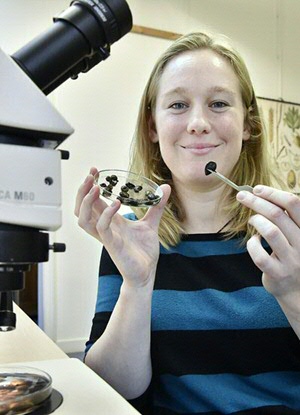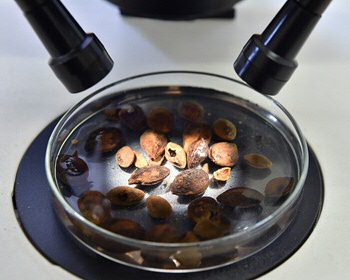Investigating cesspits to discover age-old recipes (video)

Archaeologist Merit Hondelink studies the eating habits of Dutch urban populations between the 16th and 18th centuries. To this end, she takes samples from old cesspits to find traces of prepared food. Hondelink also cooks long-forgotten dishes herself, using age-old recipes. Sometimes, this even yields additional insights for her research. In this video, she explains her research and is seen cooking an old Christmas cake called Jan-in-de-zak.
Hondelink uses samples from cesspits in Delft for part of her research. These pits still contain seeds, kernels and pollen, which she studies with a microscope. If she encounters a seed that she doesn't yet know, she turns to the seed reference collection in the department of Archaeology. This is a very special, world-famous collection that contains all seeds and kernels in their raw, burnt and even charred states and allows researchers to compare and determine their specimens.
(Text continues below the video, including the Christmas cake recipe)
The cooking of old dishes allows Hondelink to compare her own, home-made cutting marks on kernels with samples from the cesspit. This helps her to find out how they were used. It also tells her how to interpret a recipe, how seasonal these dishes were at the time and, of course, what they tasted like – quite nice, actually!
More information
- Merit Hondelink
- Hondelink has also developed a series of podcasts known as the ‘Kookpotcast’, in which everyone can cook along.

Recipe for the Jan-in-de-zak Christmas cake
The original Jan-in-de-zak cake recipe, taken from the De volmaakte Hollandsche keuken-meid cookbook from 1752, followed by a modern-day version in English: ‘Brood Podding, hoe men die maaken zal: Neemt 12 eijeren, klopt die heel klein en doet ‘er wat zout, een weinigje saffraan, suiker, nagelen, foelie en notemuscaat onder; een goed gedeelte korenten met fyn gesneden nier-vet, met twee witte-brooden die geraspt zyn: mengt die te saamen wel onder een, en doet ‘er een weinigje brandewyn by om het luchtig te maaken doet het dan te saamen in een doek of in een zakje en bind het maar niet styf toe, en kookt het gaar, is zeer goed, met saus gegeeten.’
Hondelink's modern-day version uses the following ingredients: 4 eggs, a pinch of salt, a pinch of saffron, 100 grams of sugar, ½ tsp. of clove powder, ½ tsp. of ground nutmeg, ½ tsp. of ground mace, 400 grams of currants or other dried fruits to taste, 200 grams of suet or butter, 200 grams of grated white bread, and a decent splash of brandy or cognac.
Preparation:
1. Boil the water in a nice deep pan, so that the Jan-in-de-zak won't touch the bottom.
2. Beat the eggs.
3. Cut the fruit in small pieces and mix it with the spices and spirit.
4. Slice the butter and grate the bread (with a food processor).
5. Mix everything until a compact ball has formed.
6. Butter a tea towel; this will make your cake less spongy. Put the dough in the tea towel, fold and close tightly.
7. Steam the cake for 4 hours.
8. Let it sit in a warm, dry place.
9. Steam for another 2 hours before serving. Serve with extra brandy or cognac to taste or flambé the spirit.
| Last modified: | 08 January 2024 09.52 a.m. |
More news
-
03 July 2025
Substantial financial support Nij Begun for digital coach project Groningen and North Drenthe
In all municipalities in Groningen and North Drenthe, there will be room to train people with a distance to the labor market to become digital coaches. The initiative for this comes from the Digital Literacy Coalition (DLC): a network of...
-
02 July 2025
Just Art? New project aims to harness the power of artistic research for climate justice
A large consortium receives 6,8 million euros from the Dutch Research Council as part of the Dutch Research Agenda to put art at the center of climate justice, from Aruba to the Wadden Islands.
-
01 July 2025
Khalaf Alkhalaf elected Alumnus of the Year 2025
Khalaf Alkhalaf has been elected Alumnus of the Year 2025 by the University of Groningen. He has received the award for his commitment to providing good care and guidance to refugees in the Netherlands and the inspiring way in which he shares his...
